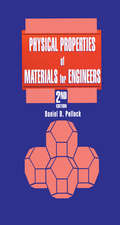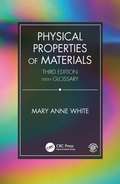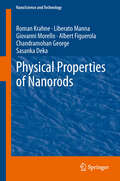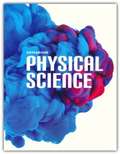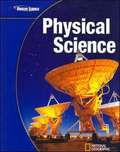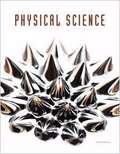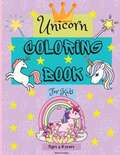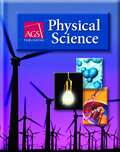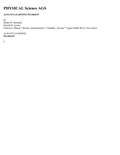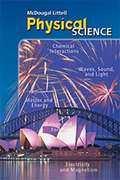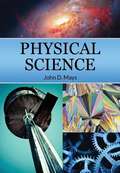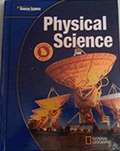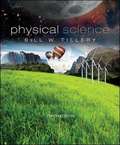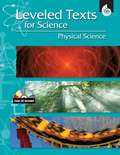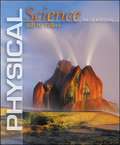- Table View
- List View
Physical Properties of Materials for Engineers
by Daniel D. PollockPhysical Properties of Materials for Engineers, Second Edition introduces and explains modern theories of the properties of materials and devices for practical use by engineers. Introductory chapters discuss both classical mechanics and quantum mechanics to demonstrate the need for the quantum approach. Topics are presented in an uncomplicated manner; extensive cross-references are provided to emphasize the inter-relationships among the physical phenomena. Illustrations and problems based on commercially-available materials are included where appropriate. Physical Properties of Materials for Engineers, Second Edition is an excellent introduction to solid state physics and practical techniques for students and workers in aerospace industry, chemical engineering, civil engineering, electrical engineering, industrial engineering, materials science, and mechanical and metallurgical engineering.
Physical Properties of Materials, Third Edition
by Mary Anne WhiteDesigned for advanced undergraduate students and as a useful reference book for materials researchers, Physical Properties of Materials, Third Edition establishes the principles that control the optical, thermal, electronic, magnetic, and mechanical properties of materials. Using an atomic and molecular approach, this introduction to materials science offers readers a wide-ranging survey of the field and a basis to understand future materials. The author incorporates comments on applications of materials science, extensive references to the contemporary and classic literature, and 350 end-of-chapter problems. In addition, unique tutorials allow students to apply the principles to understand applications, such as photocopying, magnetic devices, fiber optics, and more. This fully revised and updated Third Edition includes new materials and processes, such as topological insulators, 3-D printing, and more information on nanomaterials. The new edition also now adds Learning Goals at the end of each chapter and a Glossary with more than 500 entries for quick reference. Web ResourceThe book’s companion website (www.physicalpropertiesofmaterials.com) provides updates to the further reading sections and links to videos made specifically by the author for this book. It also offers sources of demonstration materials for lectures and PowerPoint slides of figures from the book. Many of the features (all those under Student Resources) are freely available to all, including about 30 custom made videos that specifically complement the contents of the book. These videos are highlighted at the appropriate points in the text. The book website also has many links to relevant websites around the world, sorted by chapter, to be used by students, instructors and materials researchers.
Physical Properties of Nanorods
by Albert Figuerola Chandramohan George Giovanni Morello Liberato Manna Roman Krahne Sasanka DekaInorganic nanoparticles are among the most investigated objects nowadays, both in fundamental science and in various technical applications. In this book the physical properties of nanowires formed by nanoparticles with elongated shape, i.e. rod-like or wire-like, are described. The transition in the physical properties is analyzed for nanorods and nanowires consisting of spherical and rod-like nanoparticles. The physical properties of nanowires and elongated inorganic nanoparticles are reviewed too. The optical, electrical, magnetic, mechanical and catalytic properties of nanowires consisting of semiconductors, noble and various other metals, metal oxides properties and metal alloys are presented. The applications of nanorods and nanowires are discussed in the book.
Physical Science
by Barbara Ferrier Timothy EimerLearn all about matter, energy, electricity and magnetism in this book.
Physical Science
by Dean HurdPrentice Hall Physical Science presents science as a process that involves research, experimentation, and the development of theories that can hold great explanatory and predictive power. This approach reflects the challenges and intellectual rewards available to students in the ever-changing discipline of science.
Physical Science
by R. Terrance Egolf Donald CongdonBeginning with an introduction to why we do science, the Physical Science Student Text, 5th ed., gradually builds the student's understanding of physics concepts in a logical sequence. Beginning with classical mechanics, the text progresses through work and energy, wave phenomena, electricity and magnetism, and light and optics. These transition naturally into the chemistry topics, beginning with the atomic model, then to elements and compounds, chemical reactions, and finishing with solutions, and acids, basis, and salts. Every chapter shows by example why the subject matter is relevant to a Christian worldview of science.
Physical Science
by Donald H. Jacobs Robert H. MarshallHave you ever wondered how a camera or a computer works? Do you listen to music on the radio or a boom box? Do you know how the sound is produced by these machines? Have you ever noticed that your body seems to weigh less in water? Do you know why? All of these questions--and many more--can be answered by studying physical science.
Physical Science
by Donald H. Jacobs Robert H. MarshallThis book covers the area of physical science. It also focuses on science skills that scientists use. These skills include asking questions, making predictions, designing experiments or procedures, collecting and organizing information, calculating data, making decisions, drawing conclusions, and exploring more options.
Physical Science
by Donald H. Jacobs Robert H. MarshallWith the full-color Physical Science text, students learn the properties of matter, elements, compounds, electricity, and sound and light. Students reading below grade level gain practice in working with data and sharpen their abilities to infer, classify, and theorize.
Physical Science
by Donald H. Jacobs Robert H. MarshallPhysical Science text, students learn the properties of matter, elements, compounds, electricity, and sound and light. Students reading significantly below grade level gain practice in working with data and sharpen their abilities to infer, classify, and theorize. Lexile Level 840 Reading Level 3-4 Interest Level 6-12 Features and Benefits Aligns with NCTM Standards ELL/ESL appropriate Track student progress with Skill Track Software Concepts presented in clear, simple language Problem solving and word problems encourage students to relate skills to real-life situations Relevant practice activities such as comparison shopping and figuring interest rates Supplemental problems for additional practice and review Calculator activities reinforce computation skills Over 300 additional activities available on the Teacherâ s Resource Library CD-ROM Research and Validity AGS Globe publishes high-interest, low-reading level textbooks, instructional materials, and assessments for students with a wide range of special needs. The purpose of this report is to document how AGS Globe textbooks are aligned with scientific research that supports best practices in pedagogy, instructional design, and instructional techniques.
Physical Science
by Rita Ann Calvo Kenneth Cutler James TrefilScience is central to daily life. As consumers, we are besieged by new products and processes, not to mention a bewildering variety of warnings about health and safety. As taxpayers, we must vote on issues that directly affect our communities - energy taxes, recycling proposals, and more. A firm grasp of the principles and methods of science will help you make life2s important decisions in a more informed way.
Physical Science
by John MaysCombining mastery-learning and a unique textbook philosophy, this physical science course helps students break the Cram-Pass-Forget cycle so that they truly learn and retain course material. <P><P> This physical science text is designed for grades 6-8. Physical Science is beautifulky designed and organized around the principles guiding all Centripetal Press texts summarized in the words Mastery, Integration, Wonder. <P><P> Good science instruction should draw students upward into the adult world of scientific inquiry. We start with a proven mastery-learning paradigm: through a carefully crafted program, students continually learn and build on their learning, reencountering key concepts and practicing scientific skills so that they become settled in the student's mind. <P><P> Mastery learning requires ongoing review even as new material is presented. It also takes culling the material down to a manageable amount that an average student can actually master in the course of a year. This means that Novare texts are serendipitously smaller than the usual 8-10 pound tomes. Better, more enduring learning takes place when the student goes deeper with a moderate amount of material rather than trying to cover too many topics too rapidly or shallowly. <P><P> Each chapter begins with a list of quantifiable learning objectives and important vocabulary. Chapters also include periodic Learning Checks which provide a moment to stop and review. There are 12 "Experimental Investigations" included with the book, not in a separate manual, with instructions and materials listed. The teacher's version of the experiment in on the Resource CD. Some experiments are demonstrated in Youtube videos. <P><P> integration is the inclusion of material across subjects relevant to the topic in the text: the history behind the science, grade-level mathematics, written and verbal English language skills and measurement skills. Novare Physical Science in particular even includes some discussion of epistemology (what kind of knowledge does science give us and how is that different from biblical revelation). References from the humanities are used where appropriate to add greater dimension, to humanize and decompartmentalize science, references to art, music, architecture, technology, and literature. <P><P> Finally, this text specifically devotes space to the presence of order in the universe, as well as the nature of truth, theories, facts, hypotheses, and the nature of scientific knowledge. <P><P> Physical Science is beautiful inside and out. With a mature, developed sense of aesthetics, this book is tidy and attractive. Students love the personal style of the narrative in which the author concisely and accurately explains the concepts with evident wonder and excitement at the marvels of the world.
Physical Science (10th Edition)
by Bill W. TilleryThis book presents a substantial introduction to the fundamental behavior of matter and energy. It introduces basic concepts and key ideas while providing opportunities for students to learn reasoning skills and a new way of thinking about their environment.
Physical Science (Georgia GPS Edition, EOCT Coach)
by Triumph LearningGet complete preparation for the Physical Science EOCT! Developed with Georgia educators, Georgia Physical Science Coach offers comprehensive lessons and authentic EOCT Practice Tests. That's why we're proven to raise test scores! Fully correlated to the Georgia Performance Standards, Coach has everything you need to reach students of all ability levels! Georgia Physical Science Coach provides clear instruction to help students grasp new information and develop higher-order thinking skills. Practice Tests and chapters cover essential subjects such as: Habits of Mind The Nature of Science Matter Force, Mass, and Motion Energy Build confidence before test day with our multiple-choice practice questions and testing tips. Each comprehensive lesson includes a discussion question and lesson review questions to reinforce key concepts. Georgia Physical Science Coach also provides essential extras to keep students engaged. Our "Did You Know?" sections provide high-interest factoids and helpful graphic organizers complement the lessons.
Physical Science (Georgia)
by Dinah Zike Charles William Mclaughlin Marilyn ThompsonGive every student a deeper understanding of physical science!. . Glencoe "Physical Science" integrates accurate and comprehensive coverage of physics and chemistry with mathematics through accessible text, engaging features, and a variety of hands-on experiences. The critical-thinking opportunities, real-world applications, and technology resources lead students to a deeper understanding of physical science, while building science process skills..
Physical Science (Leveled Texts For Science)
by Don Herweck Joshua BishopRoby Jane Weir Elizabeth R. C. Cregan Kyle Shuler Dennis BenjaminUncover how and why things work in our universe with 15 essential scientific concepts that involve topics in states of matter, The Periodic Table, vibrations and chemical reactions. This resource provides suggestions for differentiating instruction to meet the needs to all readers and offers four visually identical texts for each topic, each suited for below, on, and above grade levels, and English language learners. Each high-interest informational text is perfect for close reading or small-group instruction and is complemented with comprehension questions specific to each reading level. This resource is aligned to college and career readiness standards.
Physical Science (Sixth Edition)
by Bill W. TilleryAn introductory text for a one- or two-semester text on the fundamental behavior of matter and energy for nonscience majors, covering physics, chemistry, astronomy, and earth sciences. Material incorporates minimal use of technical terminology, discussion of applications and environmental concerns throughout, and historical background, with emphasis on problem-solving mathematics. Learning aids include chapter summaries, key terms, and multiple-choice and critical thinking questions. Exercises are given in two sets, one with explained answers.
